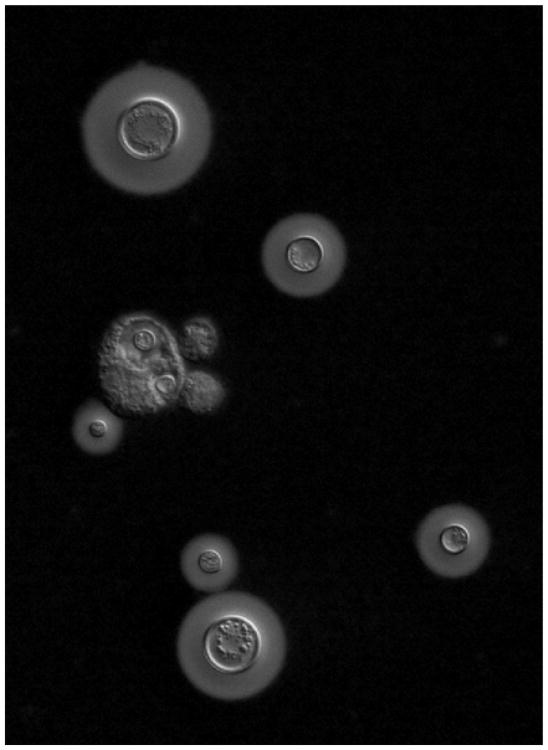What is Cryptococcus?
Cryptococcus is a yeast that is surrounded by a thick coating of polysaccharides, called a capsule (Figure 1); for this reason Cryptococcus is often referred to as ‘the sugar yeast’.
Figure 1.
Micrograph of Cryptococcus cells stained with india ink.
The polysaccharide capsule is visible as a zone of clearing around the cell body. Two normal size cryptococcal cells have been phagocytosed by host cells. In contrast, the titan cells are too large to be phagocytosed.
A sugar yeast — sounds great for making beer, bread and wine!
No, that's not Cryptococcus. ‘Yeast’ is a catch-all term for any single-celled fungus, so many unrelated fungi can be called yeasts. The common kitchen yeast exploited by humankind for millennia to ferment the sugars in food into alcohol and CO2 is actually Saccharomyces cerevisiae, an ascomycete. The Cryptococcus species were initially misclassified as Saccharomyces when two scientists independently discovered the fungus at the end of the 19th century. Sanfelice, a Sardinian, serendipitously isolated yeasts from aging peach juice. Yet his discovery was not the early precursor to the Bellini cocktail, because the German Busse simultaneously isolated the encapsulated yeast from a patient presenting with an unknown mycosis.
Cryptococcus is actually a basidiomycete yeast, more closely related to the mushrooms on your pizza than the yeast used to leaven the crust or to ferment the beer you drink with it. The early work by Busse suggesting that Cryptococcus could be a novel fungal pathogen was confirmed by subsequent animal pathogenesis experiments proving Koch's postulates that set the foundation for a century of productive research.
Thick hair, tanned flesh, buxom body, and a robust libido… a 21st century popular icon?
These terms are not describing the latest reality TV star; rather, they are the known virulence factors of Cryptococcus, its polysaccharide capsule, melanin, cell enlargement, and sexual reproduction. The thick sugary polysaccharide capsule allows the yeast to evade the host immune response by resisting cellular uptake and subsequent degradation by phagocytes (Figure 1). Polysaccharide that has dissociated from the cell also inhibits T-cell and cytokine responses, and this curious property has prompted investigation into using purified Cryptococcus capsule as a potential therapy for some forms of autoimmunity. Embedded in the cell wall, directly below the sugar coat, resides a pigment, melanin, that is capable of scavenging oxygen radicals deployed by host cells, thereby preventing oxidative damage and promoting survival inside phagocytes. The pigment can also bind to conventional fungicides and reduce drug efficacy. When the yeast is growing in the environment, melanin confers a fitness advantage by permitting the fungus to grow at wide temperature ranges, survive in high concentrations of toxic metals, and resist ionizing radiation.
Cryptococcus also forms gigantic cells dubbed ‘titan cells’, which are too large for phagocytes to engulf (Figure 1), are able to protect normal cryptococcal cells from the host immune response, and play a key role in establishment of disease. Finally, one of the sexes (the α mating type) is more prevalent in both the environment and the clinic. The α cells are bisexual — they undergo heterosexual mating with the opposite mating type, but are also homosexual, able to propagate by same-sex mating. These traits collectively distinguish Cryptococcus from many other human pathogens.
Can Cryptococcus make you sick?
Yes and no. Cryptococcus is found in the environment, in and on things we are exposed to often. Been to a city park? You've probably been exposed to Cryptococcus. Cryptococcus can live in pigeon droppings, in soil, on trees, and in other environmental reservoirs not yet fully defined. Normally, your immune system fights the cryptococcal infection and you may never know you have been exposed. But Cryptococcosis is recognized as an emerging infectious disease. Cryptococcus gattii can infect and cause disease in otherwise healthy individuals. More than 200 people have acquired C. gattii infections in the North American Pacific Northwest in an outbreak that is spreading south down the Pacific coast. In addition, Cryptococcus neoformans significantly burdens immunocompromised populations — mainly organ transplant patients on immunosuppressants and persons living with HIV/AIDS. More than a million new cases of C. neoformans are reported annually in persons infected with HIV, and even with the availability of anti-retroviral and anti-fungal therapies, the rate of survival is less than 40%.
Cryptococcal meningitis has surpassed tuberculosis as the most lethal opportunistic infection of AIDS patients in Africa. Roughly half the people that survive this meningitis are often confronted with additional complications during immune recovery. Patients can experience a clinical relapse of aseptic meningitis and non-central nervous system inflammation that can result in death. By and large, the general public need not fear infection, but cryptococcosis remains an important public health concern in specific regions of the world.
Where can I find out more?
- Casadevall A, Perfect JR. Cryptococcus neoformans. ASM Press; Washington, D.C.: 1998. [Google Scholar]
- Heitman J, Kozel TR, Kwon-Chung KJ, Perfect JR, Casadevall A. Cryptococcus: From Human Pathogen to Model Yeast. ASM Press; Washington, D.C.: 2011. [Google Scholar]



